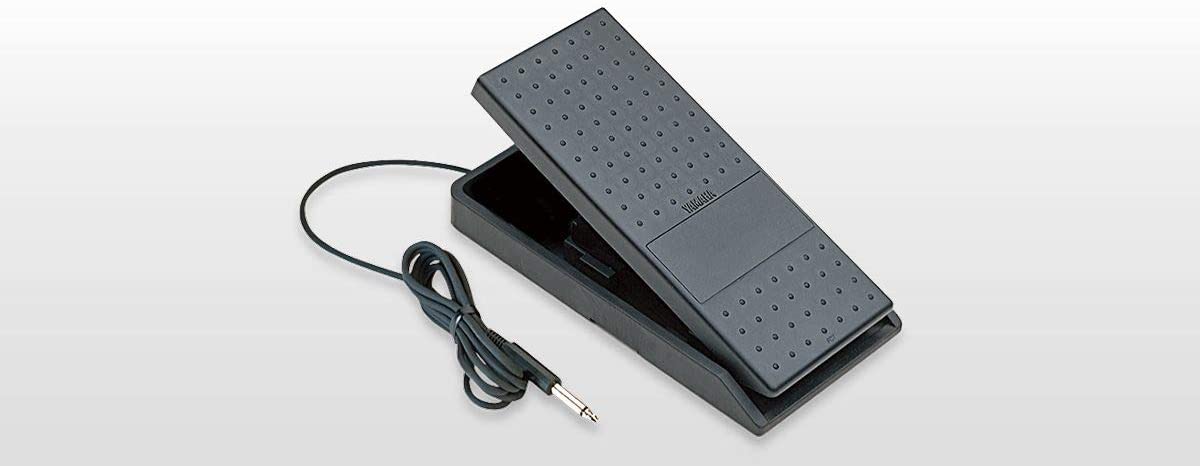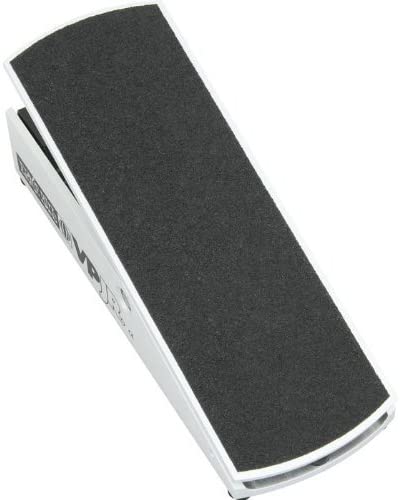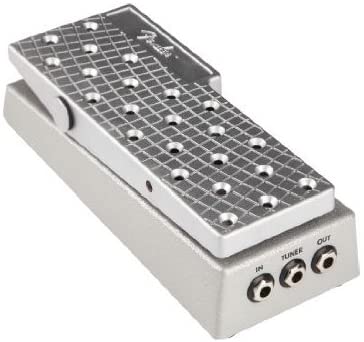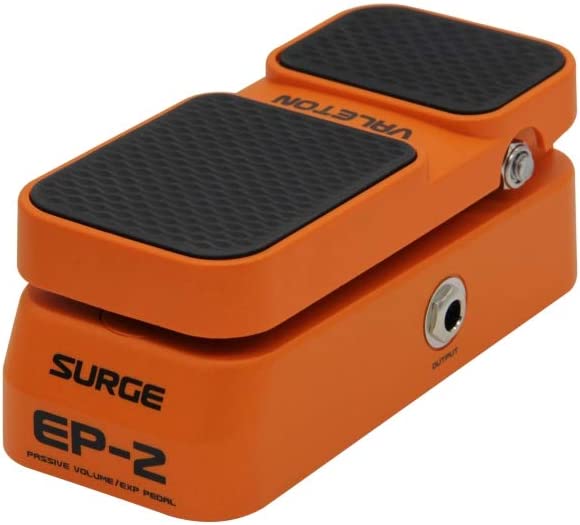Best Budget

Editor's Pick

Best Midrange

Thomas Boxtiger
Head Music Editor
Today, I'll be walking you through our list of the 5 best guitar pedals on the market. This list was compiled using personal experience, overall customer review, and pricing. Hopefully, this will help you find a pedal that suits your needs and play style as a musician.
The Top 5 Guitar Pedals Reviewed
1. Ernie Ball VP Jr.

The Ernie Balls VP volume pedal is one of the finest guitar pedals on the market today. It is a 250K ohm resistance volume pedal which delivers in terms of how expressive your music performance can be. It can also deliver amazing swells and allow you full control of your guitar’s volume throughout the song.
The durability is spot on with its rugged construction that incorporates steel pivot shafts and springs alongside durable Kevlar cables. It also includes a micro taper switch that allows you the option of using one of two swell rates.
Pros
- Amazing ability to produce great ambient swells.
- Compatible with most types of boards.
- High-quality tuner jack.
- Affordable price tag.
Cons
- A pretty basic guitar pedal but does what need to be done.
2. Yamaha FC7 Volume Expression Pedal

The Yamaha FC7 is an affordable volume pedal that comes with the fortissimo function. The fortissimo function allows you to add some accents to the guitar tone during the performance.
It features an adjustable angle for the pedal for added comfort. A spring point adjustment for better tactile feedback. A unique metal connection plate for “ganging” during the performance. The FC7 is designed for various play styles and is also compatible with the DG series amplifiers.
Pros
- Incredibly accurate.
- Quite affordable.
- Fortissimo function is a great feature if you have solo numbers during the song.
- Adjustable angle for the pedal is a welcome feature.
Cons
- A bit heavier than most guitar pedals.
3. Fender FVP-1 Volume Pedal

The Fender FVP-1 Volume Pedal is lightweight coming in at 1.2 lbs. It features a 250K potentiometer and is known for delivering high-quality natural tone with little to no sonic interference.
It uses the standard configuration of the one in and out jack which covers the basic needs of most musicians. The pedal also uses the Tuner Our Jack feature which allows you to attach a tuning device.
Pros
- Extremely durable.
- Compact size.
- Delivers precise tones.
Cons
- As it is made of the hard metal casing, expect it to be a bit heavy.
4. Valeton EP-2

The Valeton EP-2 Guitar Pedal is one of the lighter models on the market today. It features a 2 in 1 functionality which includes expression and volume. One advantageous feature this pedal has is its auto-detection of output source. It can also operate with or without a power adapter or battery, making it ideal for live performances.
It is compatible and heightens the quality of guitars, bass, and other musical instruments. The taper is smooth and is quite responsive and precise as well.
Pros
- Durable and well-made for a plastic pedal.
- Great price for the overall quality.
- Works without batteries.
- Lightweight and compact.
Cons
- It is made of plastic which is a nitpick by most musicians.
- Might be too small and compact for some musicians.
5. Boss FV-500H

The Boss FV-500H is a heavy-duty volume pedal known for delivering high-impedance quality sound. It utilizes high-grade aluminum die-cast body for impressive durability.
The smooth adjustable pedal is designed for ease and comfort. The pedal surface comes with a rubber cover for better traction and comfort. This volume pedal also comes with a tuner output jack for added convenience.
Pros
- Despite its size, this guitar pedal is surprisingly lightweight.
- Adjustable pedal tension.
- Flexible volume settings to suit each individual’s play style.
- Well-constructed. I expect this to last for quite some time.
Cons
- The design might be an issue for certain pedalboards with limited space.
2022 Buying Guide
Introduction
An instrument pedal is an essential tool for any performing musician. It allows you to quickly control the volume of your musical instrument on the fly without the need to turn off the instrument itself.
It also eliminates the need for you to manually adjust the volume knob which, if you are performing live on stage, can be quite taxing.
Also known as expression pedals, these are extremely convenient equipment for musicians today. Sure, you can still perform without a volume pedal but every musician can attest that having one will be able to deliver a ton of benefits.
If you plan on performing live on stage sometime in the future, I highly suggest you invest n a quality volume pedal.
If you play the guitar in a band, having the best guitar pedal can significantly improve your performance as you only need to focus on playing the instrument and not with fiddling volume controls.
How Do You Use Guitar Pedals?
First, let us discuss the basics of using guitar pedals. Now, hear me out, placement of guitar pedals or volume pedals will boil down to the musician’s personal preference.
Don’t think of the guideline below as the “be-all, end-all” rule. You can, however, use it to guide you in the right direction if you are still a beginner in all of this. As any artist would tell you, experimentation is the key.
Don’t be afraid to go against the perceived norms. Go with your gut instinct but also consider taking in as much information as possible in order for you to make an informed decision.
Now, in order for beginners to start off on the right foot, we will take a look at the standard practices when it comes to volume pedal placements.
The most common practice here is to place the pedal at the end of the signal chain or right before the delay. The reason why most will place the pedals on either of these positions is that it can help dampen the processed signal. Which means you get to maintain the full overdrive saturation.
Using a guitar pedal gives the musician absolute control over the volume levels while also being able to retain the tone quality. Placing the pedal in front of the delay will deliver vastly different results. In this placement, musicians can lower the volume to as low as they want while retaining the qualities that a delay pedal delivers.
This can deliver some amazing swells during performance without feeling too artificial. Whichever position you prefer, having a volume pedal/guitar pedal will significantly improve your performance.
You can also utilize the volume pedal in order to get more flexibility with the tube amp. In order to accomplish this, you simply place the pedal on the area where the amp tube will deliver maximum capacity. You can use the pedal to dampen the volume in this spot.
What to Consider When Buying a Guitar Pedal
In order for you to find the best guitar or volume pedal there are five factors that you should always look for:
- Accuracy
- Compatibility
- Functionality
- Size
- Durability
These five features are essential to make the best choice. Let us discuss each point further, shall we?
Accuracy
Accuracy is a key element when it comes to volume pedal performance. If you play in a band that utilizes each dynamic sound from each member you will need a volume pedal that can give you flexible yet accurate volume control.
However, for lead guitarists that only require their pedal to turn their volume from loud to loudest, a standard guitar pedal is the best choice.
Compatibility
Before purchasing a guitar or volume pedal, it is vital that you are 100% sure it is compatible with your equipment. You should also consider your style; will the features of the guitar pedal accentuate your performance? Does the guitar pedal work with ¼ inch cables or is it for MIDI only?
If you primarily use MIDI equipment, this is a question that you must ask beforehand. If slight changes in the tone of your guitar when using pedals distract you, you might want to check a guitar pedal that comes with a tuner output.
Functionality
The third feature you should look for is the pedal’s functionalities. There are guitar pedals that focus mainly on the volume control and there are others that can control other aspects of the music such as the swells.
If all you need is the ability to control volume levels, a standard volume pedal should suffice. If you need something more, there are guitar pedals that come with a variety of add-ons that can deliver unique sound effects.
Durability
Up next is durability. Obviously, guitar pedals will be taking a lot of punishment during a performance. The worst thing to happen is for your guitar pedal to suddenly break in the middle of a performance.
Heavy-duty volume pedals are more expensive but are best suited for musicians who will perform night in and night out. I suggest you invest in a heavy-duty one if you will be performing regularly in front of a crowd. For home use, lightweight and cheaper ones can be a good alternative if you don’t have the budget.
Finally, we have the size of the guitar pedal to think about. Musicians that already have a handful of effect pedals on hand, getting another one can turn your equipment into a confusing mess. Don’t buy a new board for a new pedal, instead go for a guitar pedal that is more compact and sleek in design.
Conclusion
Having a guitar pedal is essential for musicians. It helps give your performance more layer and depth. It also makes adjusting volume quick and easy.
Hopefully, this guide and list will help you figure out what guitar pedal will deliver what you need. For beginners, this is an important part of your musical equipment that should further smooth out some of your rough edges.
For experienced musicians, you can further improve and enhance your play style with a guitar pedal so take advantage of this nifty tool.
